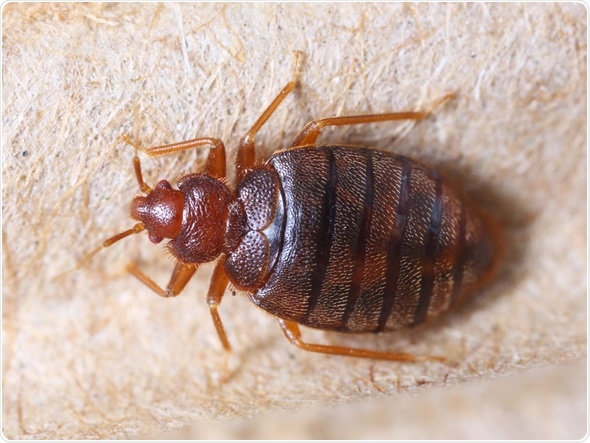Bedbugs are small insects without wings. They are a type of nocturnal parasites, as they rest during the day and feast at night, although they may also bite during the day occasionally. Bed bugs usually live in bedding or mattresses and feed on the blood of humans. Their mouth has evolved in such a way that allows bed bugs to easily pierce skin without causing pain to humans.
They are small insects (about 5 mm long) with six legs and a flat, oval-shaped body. They do not have any legs and are light brown in color, with a reddish tinge after feasting on blood. They have a small head with large antennae and large mandibles in their mouth.

Close up cimex hemipterus on corrugated recycled paper, bedbug, blood sucker - Image Copyright: Smith1972 / Shutterstock
Life Cycle
Bedbugs have a complex lifecycle with several different developmental stages:
- Egg (approximately 1 mm in size)
- 1st stage nymph (approximately 1.5 mm in size)
- 2nd stage nymph (approximately 2.0 mm in size)
- 3rd stage nymph (approximately 2.5 mm in size)
- 4th stage nymph (approximately 3.0 mm in size)
- 5th stage nymph (approximately 4.5 mm in size)
- Adult bedbug (approximately 5.0 mm in size)
Bedbugs mate through a process known as traumatic insemination, which involves piercing of the female’s abdomen and ejaculation by the hypodermic penis of the male. The sperm travels to storage areas in the body and, eventually, fertilization occurs, allowing for the production of eggs in females.
Bedbugs can survive for long periods of time, up to several months, without feeding on human blood. However, they are susceptible to very hot or very cold climates and may not survive extreme temperatures.
Interaction with Humans
Bedbugs are parasites that rely on blood to survive. They can feed on the blood of any mammal, although they appear to prefer the blood of humans. They are attracted to the warmth surrounding mammalian bodies and the carbon dioxide present in breath expiration. It is usually these factors that guide bedbugs to locate a suitable host for feeding.
Bedbugs usually bite the shoulders and arms of humans. The proboscis of the bedbug pierces the skin and allows the bedbug to feed on the blood. The saliva of the bedbug is injected into the host, which contains an anticoagulant substance that some people have an allergic reaction to.
The feed process takes approximately 5-10 minutes. The bedbug becomes filled with blood, changing in color from light brown to rusty red.
Human Reaction to Bites
The human reaction to bedbug bites varies from one individual to another. Some people do not react at all, whereas others will experience intense itching and inflamed skin. Symptoms may include:
- Large welts on skin
- Itchiness
- Reddening
- Inflammation
- Blister formation
- Loss of skin
Bedbugs have the potential to carry diseases in the body, but it is very unlikely that these diseases would be transmitted to humans when they bite them. As such, this risk is not substantial. The most severe reaction to bedbugs occurs when an individual is allergic to bedbugs.
It is recommended that people affected by bedbugs resist the urge to scratch, which may lead to scarring and infection of the skin. Instead, the bites should be washed and medications may be used to decrease symptoms, such as itchiness.
References
Further Reading